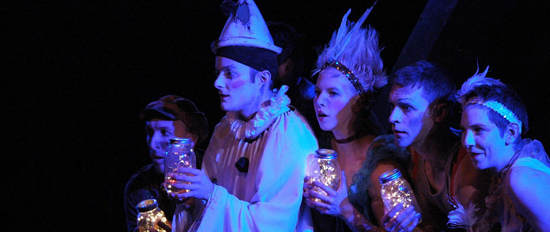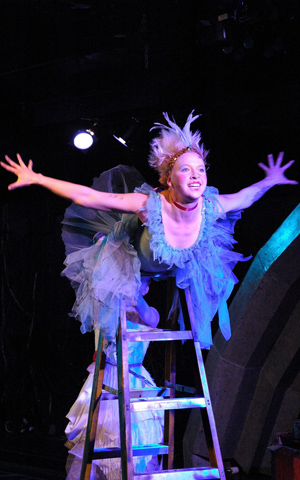Bereft clowns of ‘Burning Bluebeard’ recycle pain and guilt of 1903 Iroquois Theatre fire
 Review: “Burning Bluebeard” by Jay Torrence, at Neo-Futurists Theatre through Dec. 30 ****
Review: “Burning Bluebeard” by Jay Torrence, at Neo-Futurists Theatre through Dec. 30 ****
By Lawrence B. Johnson
One of the quiet beauties of Chicago’s theater season has sprung up in “Burning Bluebeard,” the Neo-Futurists’ rueful, physically lyrical riff on the Iroquois Theatre fire that took more than 600 lives on Dec. 30, 1903.
 This imaginative, wry and devastating play, created by company member Jay Torrence, reflects on the tragedy through a rhetorical question raised by the troupe of actors who were performing in the show or working backstage on that horrific day: If we could do it over, might the ending work out differently and all those people, the hundreds in that holiday crowd of mostly women and children, not die?
This imaginative, wry and devastating play, created by company member Jay Torrence, reflects on the tragedy through a rhetorical question raised by the troupe of actors who were performing in the show or working backstage on that horrific day: If we could do it over, might the ending work out differently and all those people, the hundreds in that holiday crowd of mostly women and children, not die?
The posh Iroquois, open only a month in December 1903 on Randolph Street where the Oriental Theatre now stands, was advertised as “absolutely fireproof.” On the day of the disaster, a holiday crowd well over capacity squeezed in for a performance of the popular musical “Mr. Bluebeard,” a silly take-off on the grim tale of Duke Bluebeard and his penchant for killing his wives. Starring was the Chicago-reared comedian Eddie Foy. He survived the fire, as did all but one of the company.
“Burning Bluebeard” imagines the guilt and heartbreak of the actors. The fire wasn’t their fault, but it was their show – and the outcome was hideous beyond comprehension. The blaze started in faulty wiring when romantic lighting was brought up for a moonlit number. In the fly space above the stage hung dozens of heavily painted scenic drops. Sparks from the wiring ignited the drops. The fire whooshed into a blaze, then exploded into an inferno. Many in the audience were incinerated in their seats.
The Neo-Futurist playbill refers to Jay Torrence simply as the creator of “Burning Bluebeard,” but any theater buff would readily call him the playwright. Radical as Torrence’s concept may be – a clutch of clowns reliving that awful event through a series of free-wheeling vignettes – it is devised with great concision, fluency and wit. The play’s disarming blend of energy, charm and pathos never flags through a single sweep of an hour and 40 minutes.
The six actors are a bedraggled troupe of clowns, their costumes singed and smudged. Most of them are accomplished tumblers, denizens of the absurd world of the stage where nothing is real and every scene and line resonates with the comedy we all live. They are sensitive souls, these poor creatures seemingly trapped in a memory loop of the Iroquois fire. Though they speak, their eloquent faces and elaborate physicality – sometimes slapstick, sometimes airily graceful — lend their words much deeper levels of meaning.
 Actually, two plays are going on at once: the hellish recycling of the fire and the macabre story of Bluebeard. Dark fare, it is dimly lit and interwoven with a deft touch by director Halena Kays. Playwright and director draw us into an existential hell, not unlike Sartre’s “No Exit” or, for that matter, Enda Walsh’s “New Electric Ballroom.” These gentle characters don’t want to be there but they cannot leave. They can’t forget, nor can they alter what has been or will be.
Actually, two plays are going on at once: the hellish recycling of the fire and the macabre story of Bluebeard. Dark fare, it is dimly lit and interwoven with a deft touch by director Halena Kays. Playwright and director draw us into an existential hell, not unlike Sartre’s “No Exit” or, for that matter, Enda Walsh’s “New Electric Ballroom.” These gentle characters don’t want to be there but they cannot leave. They can’t forget, nor can they alter what has been or will be.
Their plight, like their wistful re-enactment, is profoundly affecting. In this gloomy setting, the clown-players manage to be radiant. Their story is shattering, made bearable through stark comedy — at least up to a point. Toward the play’s end, when Eddie Foy (Ryan Walters) begins his graphic account of the fire, all the metaphorical clowning ceases, and with it Dean Evans’ infectiously droll asides as the most sober of clowns. You can read the pain of Walters’ narrative in his face, in the tension of his body: Here is what actually happened, what we witnessed and cannot banish from memory, but would change if only we could.
Watching and listening to Walters, you believe this catastrophe surely defied the power of words to describe it. Then an agonizingly extended epilogue removes all doubt. Even the words burn.
Related Links:
- History of the Iroquois Theatre fire: Check out the Deaths, Disturbances, disasters and Disorders page at the Chicago Public Library
- Ticket information: Go to the Neo-Futurists website
- Location, dates and times: Details at TheatreinChicago.com
Photo captions and credit: Home page and top: The clowns of “Burning Bluebeard,” from left, Jay Torrence, Dean Evans, Leah Urzendowski, Ryan Walters and Molly Plunk. Left: Leah Urzendowski as an aerialist. (Photos by Maggie Fullilove-Nugent). Right: Ryan Walters, as Eddie Foy, describes the fateful hour of the fire. (Photo by Evan Hanover)
Tags: Bluebeard, Iroquois Theatre fire, Jay Torrence, Neo-Futurists
No Comment »
2 Pingbacks »
-
[…] Review of “Burning Bluebeard”: Chicago On the Aisle […]
-
[…] Review of “Burning Bluebeard”: Chicago On the Aisle […]


Although this review describes the genuine and authentic qualities of this very original piece of theatre, you forget to bring up the modern ‘twists’ to the story including lip-syncing to Amy Winehouse and the ironic wink of the actors who ‘know’ that they exist in 2011 and criticize the content of their show from so long ago.
These certain factors, I thought, were cheap and unnecessary. Was it because they needed more scenes to make the show longer?
The beauty was so present in this show, and I just would have rather it been without the jolting references and presences of modern times. History, and the ‘old’ are so much more fascinating, and maybe that’s surprising because I’m a 20-something year old guy. But most of my young friends feel very similar.
Cheers to the creativity of this show.
@ Denny “the modern ‘twists’ to the story including lip-syncing to Amy Winehouse and the ironic wink of the actors who know that they exist…”
Both the modern songs and ironic winks are styles of performance traditionally employed in British Christmas Pantomimes (especially in the early 1900’s).
Since the characters in Burning Bluebeard are trapped recreating a Christmas Pantomime, the playwright and performance choices are direct references to a specific historical theatre tradition still being used in the UK. So it is actually even more historic, rather than suggesting it as a “modern” taste and pointless kitch.
Christmas Pantomimes are known for taking popular songs of the times, recognizable to the audience and incorporating them into the restaging of a fairytale. And they often change the lyrics for comedic effect which is why I loved all the brilliant mashups being used in Burning Bluebeard. I imagine it is more of a British Theatre tradition than you yanks normally are used to.
But the show Burning Bluebeard clearly informs the audience that they are here to attempt to perform the 1903 pantomime “Mr. Bluebeard.” So all of the modern mashups and aside references or winks in Burning Bluebeard were the playwright and performers making reference to a specific historical theatre tradition. Which to me all worked in beautiful subtle support to the fact that these were all characters trapped in a fairytale, retelling a Christmas Pantomime from 1903.
Employing Amy Winehouse, a british pop singer who died tragically, into a modern pantomime structured play about about an audience who also died tragically while watching a pantomime AND choosing to lip sync it for comedic effect is more genius and subtle irony than I would give most American writers credit for.
Burning Bluebeard is more than just entertaining. It is a historical feast from content to structure to performance styles all in one.
Although this review describes the genuine and authentic qualities of this very original piece of theatre, you forget to bring up the modern ‘twists’ to the story including lip-syncing to Amy Winehouse and the ironic wink of the actors who ‘know’ that they exist in 2011 and criticize the content of their show from so long ago.
These certain factors, I thought, were cheap and unnecessary. Was it because they needed more scenes to make the show longer?
The beauty was so present in this show, and I just would have rather it been without the jolting references and presences of modern times. History, and the ‘old’ are so much more fascinating, and maybe that’s surprising because I’m a 20-something year old guy. But most of my young friends feel very similar.
Cheers to the creativity of this show.
@ Denny “the modern ‘twists’ to the story including lip-syncing to Amy Winehouse and the ironic wink of the actors who know that they exist…”
Both the modern songs and ironic winks are styles of performance traditionally employed in British Christmas Pantomimes (especially in the early 1900’s).
Since the characters in Burning Bluebeard are trapped recreating a Christmas Pantomime, the playwright and performance choices are direct references to a specific historical theatre tradition still being used in the UK. So it is actually even more historic, rather than suggesting it as a “modern” taste and pointless kitch.
Christmas Pantomimes are known for taking popular songs of the times, recognizable to the audience and incorporating them into the restaging of a fairytale. And they often change the lyrics for comedic effect which is why I loved all the brilliant mashups being used in Burning Bluebeard. I imagine it is more of a British Theatre tradition than you yanks normally are used to.
But the show Burning Bluebeard clearly informs the audience that they are here to attempt to perform the 1903 pantomime “Mr. Bluebeard.” So all of the modern mashups and aside references or winks in Burning Bluebeard were the playwright and performers making reference to a specific historical theatre tradition. Which to me all worked in beautiful subtle support to the fact that these were all characters trapped in a fairytale, retelling a Christmas Pantomime from 1903.
Employing Amy Winehouse, a british pop singer who died tragically, into a modern pantomime structured play about about an audience who also died tragically while watching a pantomime AND choosing to lip sync it for comedic effect is more genius and subtle irony than I would give most American writers credit for.
Burning Bluebeard is more than just entertaining. It is a historical feast from content to structure to performance styles all in one.